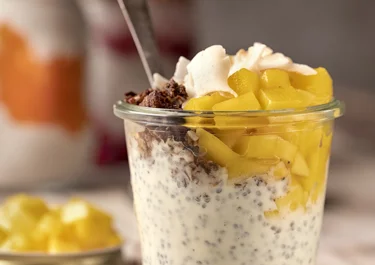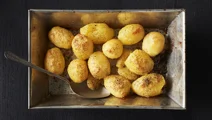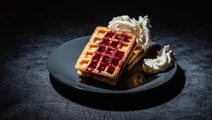Easy chia

Embark on a culinary adventure with us as we delve into the wonderful world of chia seeds. This versatile ingredient brings a delightful texture and taste to any dish, and nowhere is it better showcased than in this breakfast pudding. Its base is made with fruity skyr yoghurt for a creamy, flavourful canvas for tasty toppings like sweet mango, tropical coconut flakes, and crunchy breadcrumbs.
Ingredients
Chia pudding
|
200 ml
Arla® Skyr coconut
|
|
|---|---|
|
2 tbsp
Chia seeds
|
Topping
|
½
Loaf rye bread, toasted and crumbled
|
|
|---|---|
|
50 ml
Mangos, cut into cubes
|
|
|
1 tbsp
Coconut flakes
|
Instructions
Tips
Stir the mixture thoroughly after combining the seeds and skyr yoghurt to break up any clumps and ensure an even texture. This way, every seed has access to the liquid and develops a uniform consistency. Let the mixture sit for about 10-15 minutes. The seeds will start to absorb the liquid and expand. Stir the mixture again to break up any new clumps that may have formed.
Tips
Note that your toppings also can be added at the bottom of your serving glass to create distinctive layers. Remember to add crunchy toppings just before serving to maintain their crispness.
Tips
If you prefer a chia seed pudding that is smooth rather than gelatinous, you can blend the mixture, when the seeds have fully soaked, and the pudding is set. Blend until it reaches your desired level of smoothness.
Questions about chia
Here below, you find answers to some of the most frequently asked questions about chia.
What are chia seeds?
Chia seeds are minuscule yet powerful seeds from the Salvia Hispanica plant. They are typically black or white and have a mildly nutty taste. Their texture, more so than their taste, is what sets them apart though. When soaked in liquid, they absorb up to 12 times their weight, forming a distinctive gel-like consistency. This lends a unique mouthfeel to the dishes they are added to.
How to use chia seeds?
You can use chia seeds in a multitude of ways. Make an easy chia pudding by leaving the seeds to soak overnight and topping them with fresh fruits and berries in the morning for a satisfying and easy breakfast. You can also enjoy it as a snack in the afternoon or serve it as a dessert. The many uses for chia seeds also include transforming smoothies into thick shakes, juices into refreshing gel drinks, and giving puddings a tapioca-like consistency. They are also a popular ingredient in bars and granola. Additionally, raw chia seeds can be sprinkled onto smoothie bowls, salads, and the like.
What do chia seeds taste like?
Chia seeds taste subtly mild and nutty. It is almost neutral. This makes them an extremely versatile ingredient that can seamlessly blend into a wide array of dishes without overpowering other tastes.
Can you eat chia seeds raw?
Yes, you can eat chia seeds raw. Whether sprinkled on top of breakfast bowls or salads, or incorporated into smoothies, they can provide a subtle crunch without being soaked.
Why soak chia seeds?
Soaking chia seeds is a popular method to prepare them for consumption, harnessing their unique hydrophilic properties. When soaked, they absorb the liquid and form a gel-like consistency. This gel-like texture enhances their palatability and mouthfeel, transforming them into a soft and plump texture.
Make an easy chia pudding with our basic recipe
With this chia seed recipe making a tasty pudding from scratch is easy. Though it requires a bit of time, the process is quite hands-off, which makes it manageable even for those with a busy schedule. The key to the seeds developing their delicious, unique texture is simply combining them with liquid and allowing enough time to absorb it. As such, you can prepare the mixture the day before and have a delightful breakfast or snack ready for the next day.
A fruity yoghurt base
As mentioned, you need to mix the seeds with a liquid. You get the most flavourful and creamy result by combining them with a yogurty dairy product like velvety skyr or Greek yogurt because products like these have a great body. As the dairy hydrates the seeds and plumps them up to create their signature gelatinous texture, it can also infuse them with additional flavour. This is why opting for a fruity one with, for instance, coconut or berry flavour is an excellent choice. Sweet, tropical, and nutty coconut especially pairs wonderfully with the mildly nutty seeds because they share this delicious flavour and may enhance it in each other.
Sweet and crunchy toppings to complete the creation
A delectable chia coconut pudding is, of course, not complete without toppings. The two most important things these can achieve are to add flavour and create textural contrast with the creamy and gelatinous base. Toasted rye breadcrumbs, small mango cubes, and coconut flakes accomplish this beautifully. Together they add sweet tropical notes as well as earthy undertones pairing nicely with the fruity, nutty base. In addition, they each enhance the texture. The rye breadcrumbs are crunchy, the mango is soft and smooth, and the coconut flakes are both crunchy and slightly chewy. The result is an easy chia seed pudding full of great flavours and textures.
Use chia seeds for breakfast, dessert, or as a snack
A tasty chia seed pudding can be enjoyed at any time of day. It can make for a filling breakfast or be enjoyed later as either a snack or a dessert. Since this recipe is quite simple to scale up, you can also use it when preparing brunch or dessert for a group of people. You can serve it any way you like, either in glasses or as a breakfast bowl. In general, there are many usages for the neutral-tasting seeds, something that this easy chia recipe highlights. If you want to discover more great recipes like this one, we recommend our chia with strawberry and rhubarb, mango chia pudding, and chia with quinoa.








